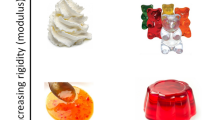We compared available methods for monitoring the integrity of in vitro models of barrier tissues and studied the possibility of using impedance spectroscopy to solve this problem. It was demonstrated (theoretically and experimentally) that TEER measurements are not sufficiently sensitive to detect small defects in the cell barrier that significantly affect its permeability. For obtaining reliable results, it is necessary to set a sufficiently high threshold TEER, which leads to the loss of many intact samples. At the same time, impedance spectroscopy has all advantages of the classical method of measuring TEER (it is rapid and non-invasive method), while its application in combination with the methods of machine learning allows reliable detection of defects in the cell barrier.
Similar content being viewed by others
References
Nikulin SV, Knyazev EN, Gerasimenko TN, Shilin SA, Gazizov IN, Zakharova GS, Poloznikov AA, Shkurnikov MY. Non-Invasive Evaluation of Extracellular Matrix Formation in the Intestinal Epithelium. Bull. Exp. Biol. Med. 2018;166(1):35-38.
Correia Carreira S, Walker L, Paul K, Saunders M. In vitro models of the human placental barrier — in regione caecorum rex est luscus. Nanotoxicology. 2015;9(Supp1. 1):135-136.
Galatenko VV, Shkurnikov MY, Samatov TR, Galatenko AV, Mityakina IA, Kaprin AD, Schumacher U, Tonevitsky AG. Highly informative marker sets consisting of genes with low individual degree of differential expression. Sci. Rep. 2015;5. ID 14967. doi: https://doi.org/10.1038/srep14967.
Helms HC, Abbott NJ, Burek M, Cecchelli R, Couraud PO, Deli MA, Förster C, Galla HJ, Romero IA, Shusta EV, Stebbins MJ, Vandenhaute E, Weksler B, Brodin B. In vitro models of the blood—brain barrier: An overview of commonly used brain endothelial cell culture models and guidelines for their use. J. Cereb. Blood Flow Metab. 2016;36(5):862-890.
Henry OYF, Villenave R, Cronce MJ, Leineweber WD, Benz MA, Ingber DE. Organs-on-chips with integrated electrodes for trans-epithelial electrical resistance (TEER) measurements of human epithelial barrier function. Lab Chip. 2017;17(13):2264-2271.
Hidalgo IJ, Raub TJ, Borchardt RT. Characterization of the human colon carcinoma cell line (Caco-2) as a model system for intestinal epithelial permeability. Gastroenterology. 1989;96(3):736-749.
Hubatsch I, Ragnarsson EG, Artursson P. Determination of drug permeability and prediction of drug absorption in Caco-2 monolayers. Nat. Protoc. 2007;2(9):2111-2119.
Kauffman AL, Gyurdieva AV, Mabus JR, Ferguson C, Yan Z, Hornby PJ. Alternative functional in vitro models of human intestinal epithelia. Front. Pharmacol. 2013;4:79. doi: https://doi.org/10.3389/fphar.2013.00079.
Larson B, Banks P, Sherman H, Rothenberg M. Automation of cell-based drug absorption assays in 96-well format using permeable support systems. J. Lab. Autom. 2012;17(3):222-232.
Nikulin SV, Knyazev EN, Poloznikov AA, Shilin SA, Gazizov IN, Zakharova GS, Gerasimenko TN. Expression of SLC30A10 and SLC23A3 transporter mRNAs in Caco-2 cells correlates with an increase in the area of the apical membrane. Mol. Biol. 2018;52(4):667-674.
Poloznikov A, Gazaryan I, Shkurnikov M, Nikulin S, Drapkina O, Baranova A, Tonevitsky A. In vitro and in silico liver models: Current trends, challenges and opportunities. ALTEX. 2018;35(3):397-412.
Samatov TR, Galatenko VV, Senyavina NV, Galatenko AV, Shkurnikov MY, Tonevitskaya SA, Sakharov DA, Marx U, Ehrlich H, Schumacher U, Tonevitsky AG. miRNA-mediated expression switch of cell adhesion genes driven by microcirculation in chip. BioChip J. 2017;11(4):262-269.
Samatov TR, Senyavina NV, Galatenko VV, Trushkin EV, Tonevitskaya SA, Alexandrov DE, Shibukhova GP, Schumacher U, Tonevitsky AG. Tumour-like druggable gene expression pattern of CaCo2 cells in microfluidic chip. BioChip J. 2016;10(3):215-220.
Srinivasan B, Kolli AR, Esch MB, Abaci HE, Shuler ML, Hickman JJ. TEER measurement techniques for in vitro barrier model systems. J. Lab. Autom. 2015;20(2):107-126.
Sugano K, Hamada H, Machida M, Ushio H, Saitoh K, Terada K. Optimized conditions of bio-mimetic artificial membrane permeation assay. Int. J. Pharm. 2001;228(1-2):181-188.
Author information
Authors and Affiliations
Corresponding author
Additional information
Translated from Byulleten’ Eksperimental’noi Biologii i Meditsiny, Vol. 166, No. 10, pp. 512-517, October, 2018
Rights and permissions
About this article
Cite this article
Nikulin, S.V., Gerasimenko, T.N., Shilin, S.A. et al. Application of Impedance Spectroscopy for the Control of the Integrity of In Vitro Models of Barrier Tissues. Bull Exp Biol Med 166, 512–516 (2019). https://doi.org/10.1007/s10517-019-04384-5
Received:
Published:
Issue Date:
DOI: https://doi.org/10.1007/s10517-019-04384-5




